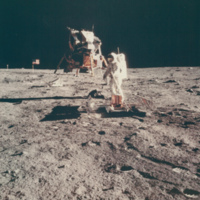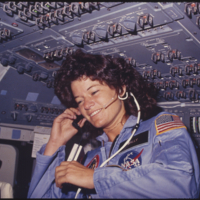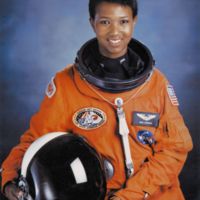Astronauts
Photograph of Neil Armstrong on the Moon. Courtesy of the National Archives and Records Administration.
The first applicants to the NASA astronaut program, competing for a spot on the Mercury project flight crew, were military test pilots. There were only a few requirements for the initial application process which included age and hours logged in flight. A key qualification, however, was a height of under 5’11”, since the Mercury spacecraft was small. After rounds of rigorous physical tests and exams, 110 pilot applicants were narrowed down to seven NASA astronauts, later known as the Mercury 7, in April 1959. Among the original seven astronauts was Alan Shepard, a Navy test pilot who became the first American in space.
Training for the Apollo crew was similarly intense. Neil Armstrong, the first man to walk on the Moon, and the other NASA astronauts had to simulate the lunar walk in its entirety. This included picking up rock samples on a fake moonscape and practicing planting the American flag on the Moon’s surface, sometimes using a simulator to mimic reduced gravity conditions. The Apollo crew also had to undergo survival training for a variety of climates—including the desert and jungle—in case they crash-landed during their return to Earth.
In the twenty years after the successful Apollo 11 mission in 1969, many other astronauts broke barriers in the NASA training program. In the 1960s, the astronaut training program was limited to white men. In 1983, aerospace engineer and astronaut Guion Stewart Bluford, Jr., became the first African American man in space. Four years later, Sally Ride became the first woman in space, after replying to an ad for the astronaut program in the Stanford University student newspaper. In 1992, aboard the Endeavour shuttle, astronaut Mae Jemison became the first African American women to travel in space. Jemison was inspired to travel to space, she later said, by the character of Lieutenant Uhura on the 1960s television show Star Trek.






